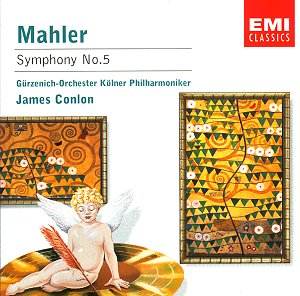Neville Cardus memorably described Mahler's Fifth Symphony as 'one
of the seven wonders of the musical world'. From this it can be taken
that any performance by a good quality orchestra and conductor will
reveal insights into this miraculous score. And so it proves here, even
if the Cologne orchestra does not immediately suggest the Mahlerian
pedigree of the Vienna Philharmonic, the New York Philharmonic or the
Concertgebouw.
In fact it was this Cologne orchestra who gave the first performance
of Mahler 5, so their recording from 1994 takes on a special meaning.
Not that the present generation of musicians has much, if anything,
to do with those players who appeared under Mahler's baton. But at least
it is a nice touch, the more so since the orchestra has maintained its
proud traditions in the intervening period of a century or so.
James Conlon has built a distinguished record as a conductor, both
in live performances and through recordings, and his Mahler displays
a sure control and a deft touch. His tempi are direct, generating a
symphonic impulse which is full of momentum. The work is cast in three
parts, with the first pair and the last pair of movements thematically
and expressively linked. At the heart of the Symphony lies what Mahler
described as 'the very devil of a scherzo'. This large-scale movement,
some twenty minutes in dureation, is in fact the jewel in the crown
of Conlon's performance.
Following the composer's advice, the tempo here is steady rather than
fast, so that the rhythms achieve due impact in building the music's
strength. From this basic pulse the contrasting waltz material achieves
a natural sense of growth and flow, beautifully balanced in the perspective
of the recording. This procedure, allied with the nature of the recorded
sound, generally tends to suit the more intimate aspects of the music
better than the richly textured or the virtuoso aspects of the score.
For example, the starring role of the trumpet makes less impression
than it might. This is apparent from the very first bar, when there
is a decided reticence about the instrument's recorded balance, though
the playing seems assured enough.
For there is room for more richness in the sound spectrum than EMI
provides. In particular the strings lack bloom, and it is difficult
to tell whether the fault lies in the recording or the playing. The
famous Adagietto for strings and harp provides the obvious focus for
consideration, and whatever the tenderness and compassion in the phrasing
and tempo, the sound itself can make more impression that it does in
this recording. Rather better is the finale, whose momentum and contrapuntal
ingenuity drive the music along. Here and elsewhere the percussion make
their point, and in many respects the timpanist steals the show. But
in general terms there is decided lack of heart, although boosting the
volume does help.
This is a powerful and a complex work, one which demands high standards
from all involved, including the attentiveness of the audience. Mahler
knew of the music's complexities, saying 'would that the first performance
could be given fifty years after my death'. And in a sense he was right,
since it was only during the 1960s with the popularity of the long-playing
record that the 'Mahler boom' really began.
As ever with this composer, the symphony proves to be a journey traversing
the struggles of doubt and belief, through this world and toward the
mystery which is the next. As such the music needs to command the indulgence
and commitment of the listener, as moreover it does the technique and
artistry of the players. Despite many fine things, this performance
cannot rate with the best, with for example Barbirolli (EMI), Bernstein
(DG) or Inbal (Denon). What is more, the accompanying booklet is frankly
inadequate, with notes which are all too brief and generalised, along
with a preference for design over content.
While this performance undoubtedly has its merits, in the final analysis
neither the music making, the recorded sound nor the general presentation
ranks among the highest standards to be found in this repertoire.
Terry Barfoot


